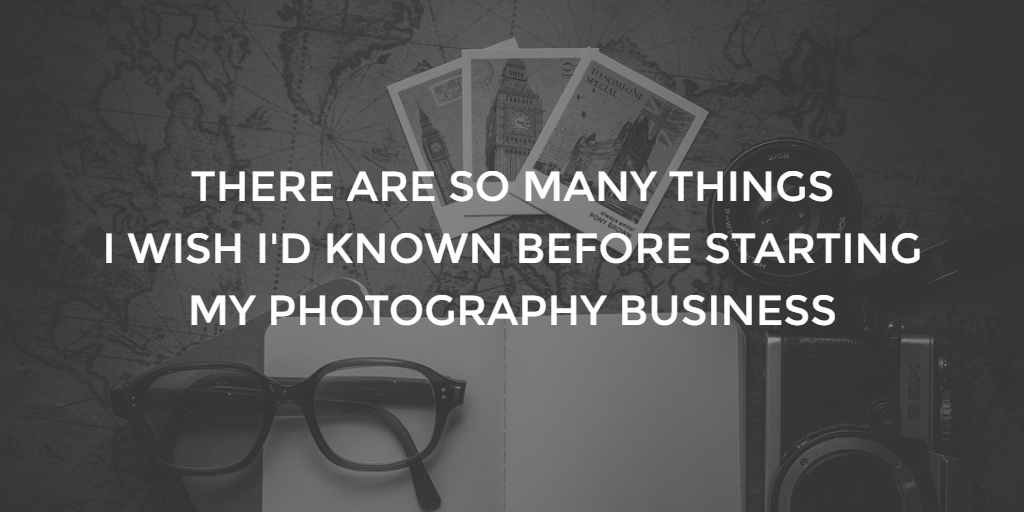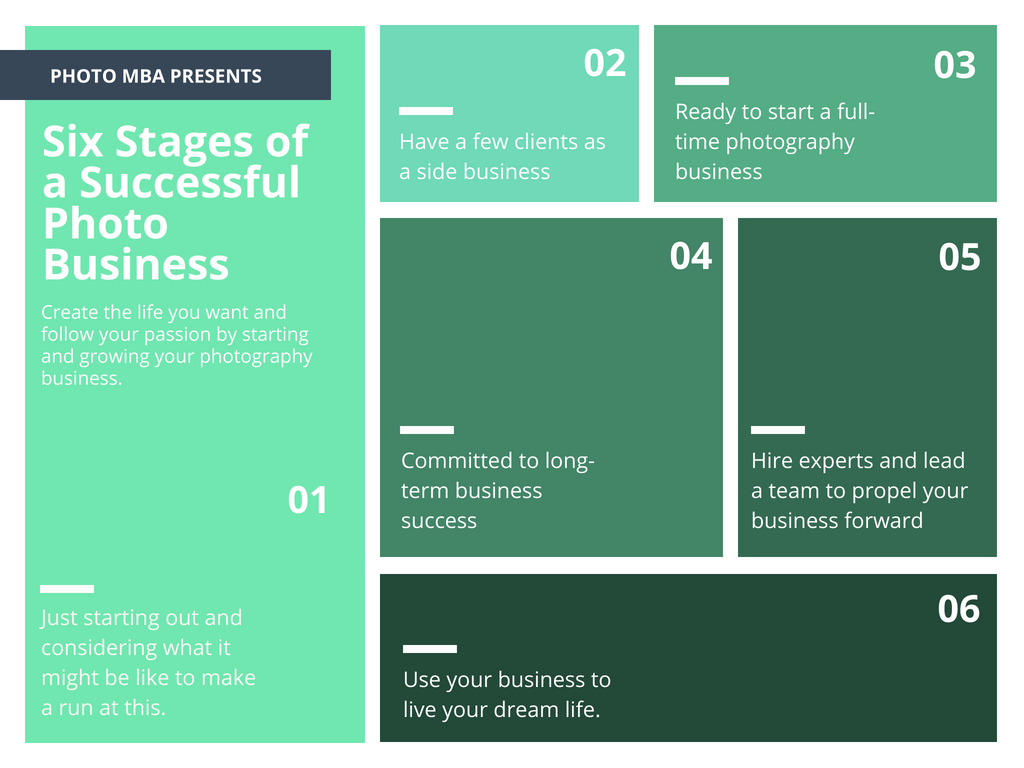
This article was last updated December 1, 2024.
The number one question that successful photographers get asked is how to start a photography business. People see their work, travel, money, and lifestyle and want that for themselves.
Odds are that you’ve had a fair bit of experience and have been shooting for a while, and now you want to turn your passion for photography into a business.
Choosing to start a photography business and take it serious is a huge leap, primarily because most young photographers don’t know about or care about the business side of the business.
You want to focus on the gear and create amazing photographs, but unfortunately, neglecting business will mean death for your budding photography career.
In our 2025 guide, we’ll cover four of the most important aspects of getting started:
-
- Understanding the “Small Business Owner” Mindset
-
- The Cost to Start a Photography Business
-
- How to Start a Photography Business “Legally”
- The 3 Biggest Mistakes People Make When Starting Their Photography Business
The fact of the matter is that you need to focus on steps 1, 2, and 3 before you can worry about 4-500. Too many startup photographers start with social media because it’s easy and familiar, or worse, they dive into the market and just start shooting quickly making all sorts of pricing and positioning mistakes.
Let’s dive in…
A Quick Note About This Guide
This is a really long article and is separated into two parts:
- Tips and technical information about starting a photography business
- The six stages of starting and growing your photography business
If I had this guide when I started my business, I would’ve done two things with it:
- Read the entire thing through beginning to end
- Print it out and refer to it often (at least the second half with the six stages)
Understanding the “Small Business Owner” Mindset
99% of photographers never planned on having being a business owner. They maybe say themselves, at best, as a freelancer who got paid to do work.
Their confidence in their photography work is high, but they feel like they’re mediocre, at best, at business. If you’re like me, photography has always been an escape from academia. I’d rather express myself or tell a story with a camera than sit in a classroom.
Let’s face it, you don’t start a photography business because you want to own a business. You want to take pictures. Plain and simple.
Except when it’s not simple. At all.
There’s marketing, branding, pricing, packaging, confidence, and a ton of other tiny business aspects that soon become an equally important part of your business.
The Cost to Start a Photography Business
The cost varies greatly as a photographer whether you’re starting out or looking to grow your existing business into something larger. Here’s we’ll cover the minimal costs for a beginning photographer or you can check out the costs associated with growing your photography business and taking your business to the next level.
The Minimum Viable Business (MVB)
I like to call this the MVB because it’s the size and scale necessary to cover the costs of your gear and other expenses (listed below) all the way up to your spaghetti number (the amount of money you need to survive if you ate spaghetti every night).
If you’re looking to grow your MVB into something larger and really go full time with it, check out our 2025 Guide to Growing Your Photography Business.
Don’t Stress the Gear
Okay. It’s tough love time. Get ready.
The gear doesn’t matter. You want me to tell you what gear to buy because, deep down in your subconscious, you think that if you have the gear the best photographers use, you’ll be as successful as them.
But don’t feel bad. We do this in almost every area of our life. Bookshelves full of unread books, closets full of unworn clothes and cupboards full of cooking gear we’ll never use. We got it because we wanted a shortcut.
New photographers think gear is a shortcut. It’s not. It’s just not.
If you’re starting out, get a Nikon D5100 or a Canon Rebel T3i.
If you’ve been around for a bit and already have one of those cameras, get a Nikon D750 or a Canon 70D.
More tough love coming: There’s no difference between Nikon and Canon. I’m not going to debate it. If you need *me* to pick one for you, are you really sure you’re going to be able to run a business if you can’t even decide between cameras? I’m being a bit harsh, but I want you to see it for what it is. You know I love you.
I got my first Nikon because my buddy had an awesome lens that I wanted to borrow. You should do the same, especially if you’re starting out. Get the same camera brand they have and mooch as much as you can to learn how to use new gear. BUT be willing to do the same for them.
You won’t be more successful if you choose one over the other, so it doesn’t matter.
Lenses are the same. Here’s what to get:
- Beginner: 50mm f/1.8 for Canon or a 50mm f/1.8 for your Nikon
- Advanced: Grab the 50mm above plus a 35mm and 85mm (Canon) or get a 35mm and 85mm for your Nikon.
One final time, gear is an excuse not to focus on what really matters: running a business successfully and telling amazing stories with your work.
What about all of the gear you “need” other than what I listed above? Here’s a helpful consolidated shopping list for you.
Done. Let’s move on 🙂
Serious Business is Serious (Yay Legal Stuff!)
You’re reading this because you want to start a business and part of that means being an adult (not that you aren’t, but you’ll get what I mean in a second). Being a freelance photographer with a DSLR who does weddings for $250 is dangerous. Here’s why:
You’re shooting a wedding and take a flash photo that catches a waiter off guard. He trips and falls, spilling hot coffee on the groom’s mother, who is burned by the drink.
Who’s to blame? She sues both you and the venue, but since you don’t have a legal entity, insurance, or anything to fall back on, you can lose your home and everything you (and your family) owns.
This is business. This is serious business.
We’ll cover exactly how these work together in a moment, but for the sake of looking at the expenses related to starting a photography business, we’ll list them here:
- Incorporating your business
- Accounting Services
- Invoicing Service
- Photography Business Insurance
- Photography Contracts
- Legal Fees – I always advise having an attorney look over your incorporation, insurance and contracts. We live in an extremely litigious society and you need to protect yourself and your family. Additionally, you need to be able to enforce contracts with other vendors and clients.
The Tech Stuff
As I mentioned above under gear, tech stuff is often used as an excuse to procrastinate. Can you imagine if some of the greatest photographers in the world thought they couldn’t start their business until they got the latest imac or freaking lightroom?
I say that, starting out with your MVB, use whatever you have available. But as you start to grow, look into some better tech such as:
- 21″ iMac Computer
- 2 Backup Hard Drives
- Screen Calibrator
- Lightroom & Photoshop
Let’s talk briefly about websites. As a photographer, you’re in the client services business. This means that potential clients will judge your photography based on the quality of your website. If you’re doing SEO, content marketing and social media correctly, one of the first major touch points a potential client will have with you is your website.
In addition to having a beautiful site (Zenfolio or Smugmug are also options), it has to have great on-page SEO options so I tend to lean towards WordPress versus any other themes.
- Theme: Choose from one of the portfolio or Photography themes on Theme Forest
- Hosting: Bluehost if you’re at MVB and Siteground if you’re more advanced.
Business Education (This is the most important part)
I used to run a full time portrait/wedding studio and we joked that it was 90% business and 10% photography. It’s is accurate though. – Darlene (Digital Photo Mentor)
You’ve likely paid for a course on improving how you use your camera or how you use photo editing software. Your skills as a photographer are the most important part to getting started, but once you start a photography business, the game changes fast. If you want to keep getting paid what your worth for the skills you put so much of yourself into, you need to learn business.
If you’re at MVB, I’d highly recommend our free 7 day course that will change how you think about running a photography business. Start making your business work for you instead of the other way around.
If you’re more advanced, I’d recommend becoming a member of The Photo MBA. Taking amazing photos isn’t the reason that most photography businesses fail (or never get off the ground). It’s all of the other stuff like marketing, clients, and sales. Learn all of it from somebody who learned it in the trenches. (Coming Soon)
How to Start a Photography Business “Legally”
I have a secret to share.
There’s a part of “business” that even I, the “photography business guy” hate.
I’ll be honest with you. I love wheeling and dealing, hustling, writing, and even the idea of “How to Start a Photography Business” has me pumped up enough to write about 3,000 words on it.
I L-O-V-E the business side of photography business. But the legal stuff? Not so much.
No thank you, taxes.
No thank you, LLC or S-CORP.
No thank you, accounting.
Yuck.
Can’t I just spend my time making more money?
Unfortunately, even I have to be an adult and do the hard work that makes a business run successfully.
And despite what the internet wants us to believe, there’s more to starting a business than creating it’s Facebook page.
You Need Structure to Function
You need *a* structure, more specifically. Here’s 3 great options:
Sole Proprietor – This is the easiest but it also leaves you the most vulnerable. If for some reason you’re ever sued, they can go after all of your personal assets. Your home, vehicles, and even your collection of Cal Ripken Jr. baseball cards (no? That last one is just me, then.). If you care about yourself, your future, and want to be a professional, this isn’t right for you.
Limited Liability Corporation (LLC) – Ah, now we’re talking. An LLC separates your liability for business and personal holdings. There is some paperwork to file in your state, but if I remember correctly from when I started my LLC, you can do it online in most states. The name of your photography business LLC doesn’t matter at all, just don’t make it ridiculous in case it has to go on paperwork in the future.
S-Corp – As a single person photography business, there’s no reason to look into this costly and more complicated option right now. In the future, it may provide a better tax situation for you, but if you’re just looking to get started, don’t worry about it and just get an LLC.
Then, grab your EIN from the IRS website and you’ll be ready to roll.
The 3 Biggest Mistakes People Make When Starting Their Photography Business
There are always things you look back and wish you would have known when you started your photography business.
Here’s 3 of the most important:
Rookie Mistake #1: Failing to Set and Anchor Prices
In our guide to creating profitable photography packages, I covered how to anchor your prices. The anchor is the price point by which your future client will judge all of your other prices.
If you’re starting out and think you need to be cheap to compete because you’re “just getting started” you’re dead wrong. You might even end up positioning yourself as a price competitor within your local market and that’s a VERY dangerous place to be. If you think you need to be cheap, you’re dead wrong.
Set 3 price points and anchor yourself against the top package. If your top package is $1,500 and that makes you uncomfortable, great! Your potential client will purchase the middle package (most do) at a more moderate, but still profitable price. However, they see you as the $1,500 photographer and not the “$50 guy.” More on that guy is Mistake #3 below.
Rookie Mistake #2: Not Embracing Content Marketing
Let’s talk content. No, not photos. Writing.
I’m a photographer, Brendan. Why the heck do I need to write?
Honestly, because words tell stories in ways photographs don’t (the same is also true vice versa). But also because Google doesn’t have a way to search images yet. If people want to find a photographer that has shot at a venue they’ve booked for an event, they are going to Google “venue+photographer” and see what comes up.
Maybe some day Google will be able to recognize the location in the images and geo-target where they were taken or something, but until then, you need to make content around ALL of your work.
That’s the content, now the marketing.
Great content marketing means making compelling content and also getting it in the right hands.
“Hey [venue], I just did a shoot on location weekend and I wanted to share with you how it turned out. What I love about shooting at your location is…….. One of the biggest challenges was …… but I was able to overcome it by….. I’d love to give you guys the rights to share the photographs that are in my article about it, as well as ask the opportunity to shoot there again in the future.”
They’ll share what you’ve done with people booking their venue and “Viola!” you get new clients.
This is only the tip of the iceberg when it comes to my content marketing strategy for photographers. Be on the lookout for our full guide coming soon.
Rookie Mistake #3: Using the “Free Shoot” Incorrectly
Some “pros” (note the use of quotes) will tell you never to do a free shoot because people then expect it. That’s ignorant, incorrect, and shows they an amateur at business. They’re ‘transactors’ and only think about the money for service exchange.
If you really want to master this business, you have to think bigger.
What if I could do a free shoot that will get me more business later? Great! In fact, that’s the only reason you ever do a free shoot. If your family and friends respect you, they’ll pay for your photography. I’m great friends with the photographers that photography my family and friends and I always pay full price because I know what their skill is worth.
Whenever you’re considering a shoot for free, you need to make it very clear from the start what you charge and why you’re doing it for free. One of my favorite companies is Lamon Luther, who are very successful, but when they first started, I bet they were strapped for cash. Here’s how it would go:
“Hey Brian, here’s the deal. For what you’re looking for, I normally charge around $3,500. But I know you’re a growing company and you don’t have that kind of money for professional photography. So here’s what I want to do. I believe in your mission to help employ and empower men affected by homelessness and addiction. What you’re doing is going to make a significant impact and change lives and I’d be proud to have my work be a part of that story.”
After the shoot, you can even provide an invoice or document with your stated fee and the discount you provided. This, again, helps to anchor you to your professional price.
I would also be remiss if I didn’t add (and this advice might save you years of work and make you thousands of dollars):
The client who hires the $50 photographer never comes the client that hires the $5,000 photographer. AND even if they do become that type of client, they certainly won’t be looking to hire you, the $50 guy.
The Six Stages of Starting and Growing Your Photography Business
When I was 22, I was invited by a friend’s family to visit Mackinac Island.
A small, isolated, island-town in northern Michigan, Mackinac didn’t offer much in the way of entertainment and it was there that I read through the entirety of Malcolm Gladwell’s Outliers.
If you’ve never read his work, Gladwell studies top performers and discovers trends that are true across the various groups he studies.
One of his most notable points is called the “ten-thousand (10,000) hour rule.”
No matter what, Gladwell states, you need to put in at least 10,000 hours before you can achieve mastery in anything and the sooner you can reach that number, the better.
No matter what, building this business is going to take time.
Whether you’re a hobbyist just starting out looking to get that lucrative first paying client, or you’re a budding entrepreneur that employs multiple photographers… then you will relate to the stories below.
However, the most important thing you’ll find below is a roadmap to follow along. No matter where you are on it, you can see the next step ahead.
The Photography Business Roadmap
The number one question that I get from photographers is:
What do I do next?
All anybody ever wants or needs to know is what they should do next when they start their photography business.
The roadmap that follows lays out everything you need to know to grow and take your business from one level to the next; all the way from starting your photography business to a thriving self-sustaining business entity.
The best way to use this article is to scroll through, find what stage you’re at and learn about what you need RIGHT NOW to figure out the challenges that you’re facing.
Despite that, I sincerely encourage you to read through the entire article and see what you may have missed in a previous stage, as well as what challenges and decisions you have coming your way in the future.
Finally, bookmark this page (or print it out) so you can come back and refer to it on a regular basis.
Whenever you feel like your business is failing or your drowning, just come back to this guide and follow the success factors to continue growing your photography business to the next level.
Stage 1: Just Starting Out
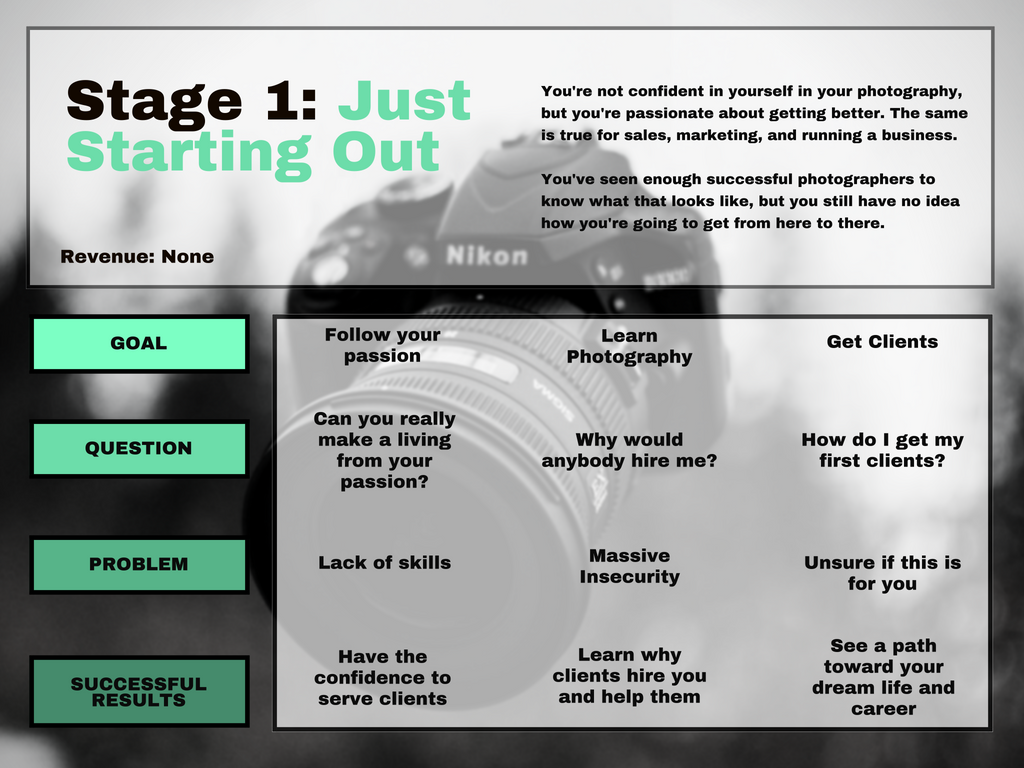
Revenue: None (yet!)
Problem: No support system and no long-term vision. Additionally, you’re not only lacking in the business skills, but also the photography skills needed to be successful.
The worst part?
You know all of this and it’s KILLING your confidence. How are you ever going to get clients if you don’t even believe that you should get paid for photos?
You want to know if you can actually build a business out of this, level up your photography skills, and follow photography as a career path.
How to Be Successful: You’ve been taking photos for as long as you can remember. Nothing quite feels the same as when you have a camera in your hand.
And now you want to make it your livelihood.
Sure, you can go to school for this stuff, but so many of the best photographers find it later in life. Either their parents never would have let them go to college for photography, or they just never knew they had such a passion for it.
Some of the world’s best photographers started because they hated their 9-5 and photography was a path toward freedom.
So you got a camera.
Now what?
Most photographers start taking photographs for free, which is totally wrong.
But it is SUPER frustrating to try to build your portfolio.
How can you get paid for work that nobody has seen you do?
One way to get things rolling is to work with another photographer. All of the top photographers need a second shooter and it’s the fastest way to learn the skills (and business) of photography.
There is nothing more rewarding in life than being able to make a difference in somebody’s life through your photography.
And right now is that time to do some of that. Serve people you want to serve. Support causes you care about with your skills.
Because that’s what I want you to figure out at this stage:
Is this something you’d do even if you weren’t getting paid for it? And, is this something you want to keep doing into the future?
Once you have an answer to that and you’ve seen how others a few steps ahead of you are succeeding in the industry, you’ll have a clear path forwards.
You’re successful at this stage in starting your photography business when:
- You have the confidence to serve clients
- Learn why clients hire you and help them
- See a path toward you dream life and career
Want help achieving those goals? Sign up for our free email course.
Stage 2: Photography Side Hustle
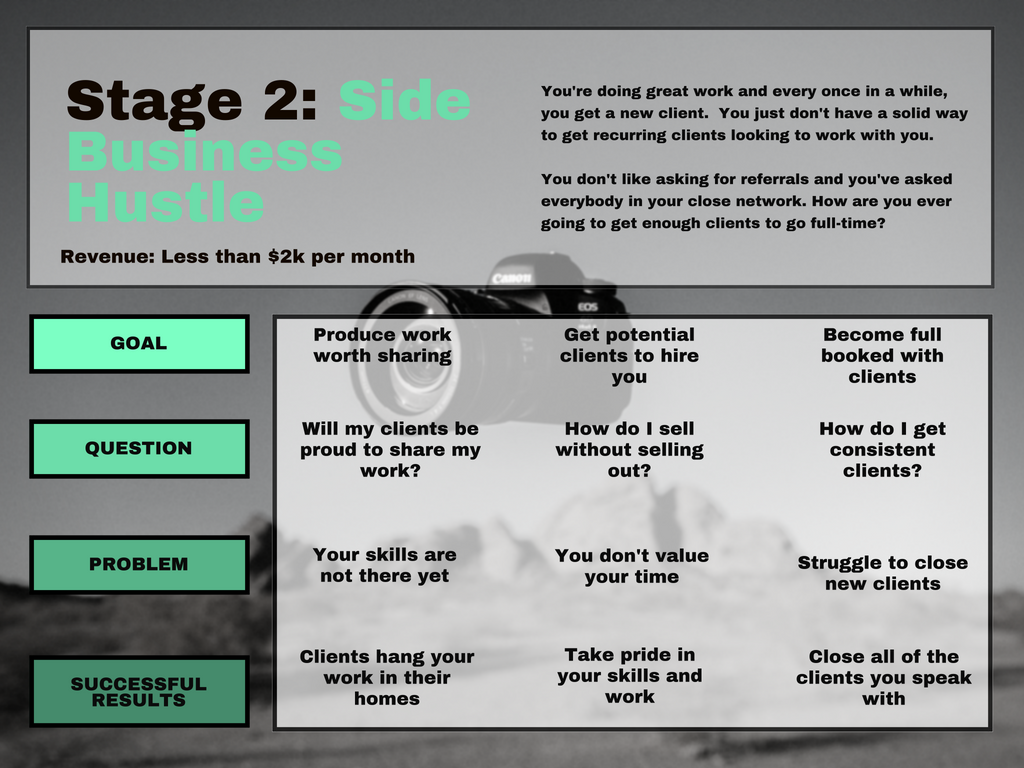
Revenue: Less than $2,000 per month
Problem: Your skills aren’t there yet. You don’t value your time. You struggle to close clients.
You’ve been loving the work that you’re doing, but you’ve still only close a few clients. You first thought is that it must be your skills. You’re just still not that good of a photographer.
What if I told you that you’re wrong?
Your ability to close clients has very little to do with your photography skills.
Did you know that the likelihood that physicians are sued has nothing to do with their skills, either? It has almost a direct correlation with their bedside manner. Physicians that clients like best are much less likely to be sued.
You get uncomfortable just asking for money and don’t value your time enough to walk away from clients that don’t want to pay you what you’re worth.
If you’re ever going to get fully-booked, and produce work you’re proud of, you’re going to have to learn the skills of business in addition to the skills of photography.
How to Be Successful: If you want to be successful, you’re going to need to learn to market yourself and sell your work.
Sales.
Sales matter more than anything else in your business.
Selling yourself online and in-person. If you want to have the audacity to build a business out of your passion, you need to learn salesmanship.
Does that mean I’m saying you need to put on a cheap suit and start hocking infomercial products and used cars?
NO! You’re not selling things people don’t need (and in most cases, don’t want).
You’re serving people, not pushing something on them they don’t want.
Pat Flynn has the motto of “serve first,” so when I talk about sales, that’s what I mean.
Sales is getting into the headspace of your client and helping them meet the needs they have. What is their goal with hiring a photographer (it’s not to get some pictures)? Why is that important to them? How committed are they to achieving this goal?
Very few things will drive your business forward more than learning to sell.
I remember in 2010 when I was working as a teacher and decided I’d had enough.
It was insane, telling my wife how I wanted to start working nights and weekends. Not at a job with a predictable wage, but starting my own business.
- Who was I to want this kind of life?
- Who was I to be able to make it happen?
- How would I keep clients coming in the door?
But then it happened. I got a few clients and I got that tiny taste of freedom. Even if I got fired the next day, I knew I was on to something. I now knew that I could put together some income if I needed it.
It sounds INSANE, but I still remember that tight feeling in my stomach when I saw my first payment from a client come in.
But with revenue comes new problems, which we’ll tackle in Stage 3 below. Pretty soon I was:
- Working my 9-5 AND my 5-9.
- Instantly losing all of the freedom that I thought I had
If you’re here right now, trust me, you’ll be FINE. The freedom of starting a photography business comes in cycles. It comes back around soon. I promise.
You’re trading one job for another. Instead of freedom, you now just have two jobs.
So how do you bridge the gap? How do you go full-time? Keep reading.
Ready to get some of your time back? Check out Zero to Photo.
Stage 3: Start a Photo Business
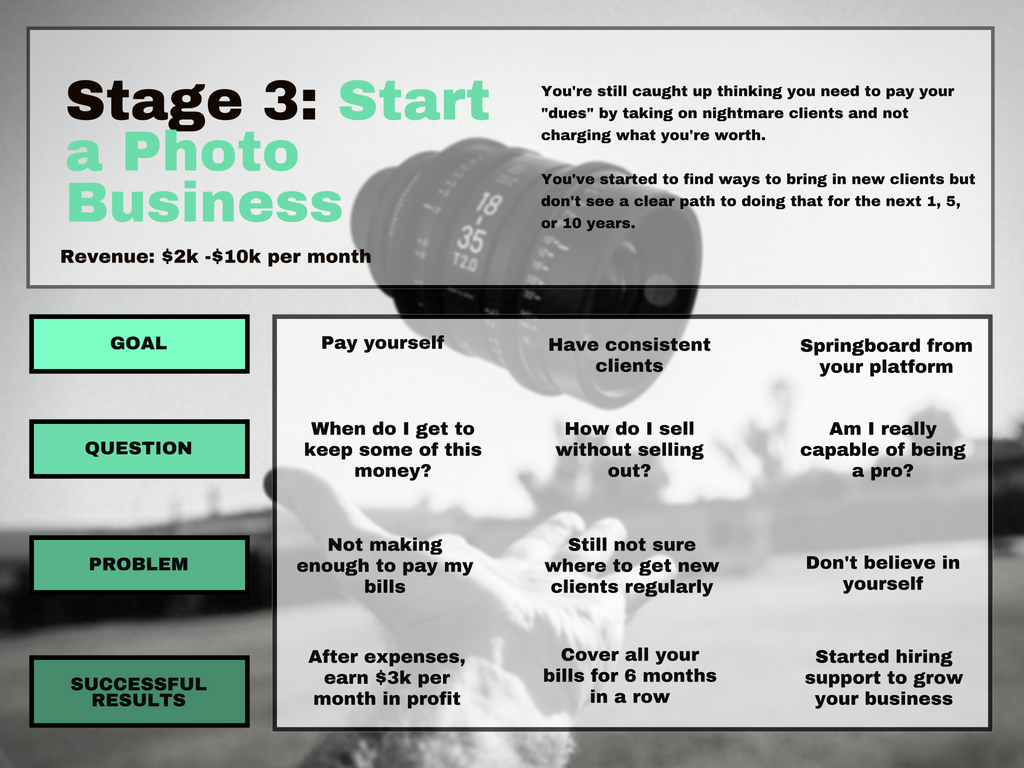
Revenue: $2,000 – $10,000 per month
Problem: You’ve gotten a few clients and continue to get a few every month throughout the year. But, you still haven’t gone full-time (or if you have, you still supplement with outside income). You probably think that in order to make this work, you need clients that pay more and MORE of them. You’re right on both counts.
But there’s still this nagging limiting belief that this life can’t be for you. You’re just a normal person. You aren’t some sort of unicorn. Either you need to grind it out for a few more years until you’re ready for “success,” or you just don’t believe it’ll ever happen.
How to Be Successful: For most professional photographers, including those I’ve worked with personally, this is a really special stage in your photography business.
There’s a good chance that you’ve figured out one method of getting clients: Google, Social Media, Networkings, etc. But, that pipeline of clients isn’t going to help you meet all of your business goals and if it ever dries up, your business is sunk.
This stage is a stage of systems. Systems and tools to bring in new clients and deliver great work.
Re-investing your money not only into your gear (you do NOT need a new camera, I promise), but instead into CRM software, email marketing software, team members, etc.
In order to grow, you’re going to need to reinvest.
To push past this stage, you’re going to need to develop systems for:
- Getting new leads and nurturing them into clients
- Staying in touch with leads and clients
- Getting testimonials and referrals
This will be the stage where you have to remember why you started this. You dared to dream about a life where you could photography what you wanted to when you wanted to and get paid for it. You’re going to need to commit and take your business seriously.
Business-owner first. Photographer second.
Stage 4: Committed to the Success of Your Business
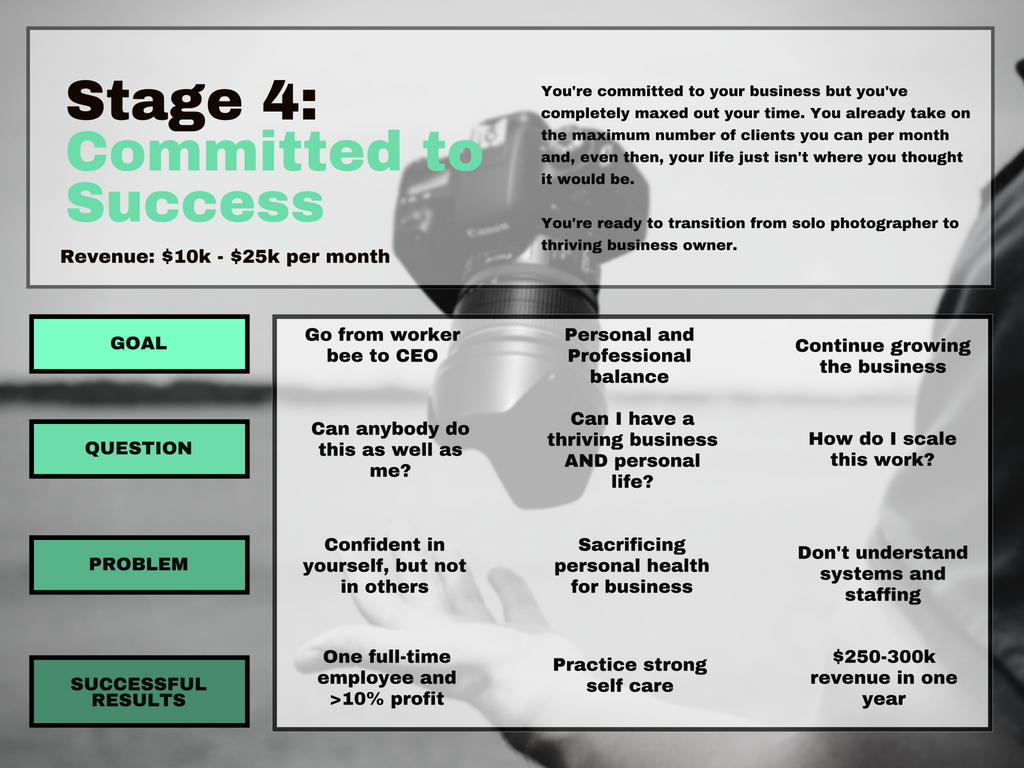
Revenue: $10,000 – $25,000 per month
Problem: You’re committed to your business but you’ve completely maxed out your time. You’re fully booked and seeing the maximum number of clients possible. Even so, you’re life isn’t anywhere near where you thought it’d be.
How to Be Successful: It’s time to transition from solo photographer to thriving business owner. If you’re going to make more money, you need to charge more or take on more clients. Since you’re already at the highest end of the range for your work, the only solution is to take on more clients.
This means putting systems and staff in place and learning new skills to hire and manage them. Taking photos and running a solo business is VASTLY different than managing photographers, editors, and marketers.
What if hiring these new people doesn’t work? Will you have to sacrifice your income to grow the business?
I remember when I first decided to hire somebody to help me in my business.
It was an absolute nightmare and I had no idea what I was doing. I knew I couldn’t keep doing it on my own, but I didn’t even know where to begin.
I just knew that my wife and my new son depended on me figuring it out. I knew the solution wasn’t just to “hustle” more, but there was SOME way to figure it out, right?
The stage of starting and growing your photography business will be about setting goals with clarity and ruthlessly pursuing them by:
- Positioning your business as not only better, but entirely different, than the competition in your area/niche
- Managing all of the new parts of your business without micro-managing them.
- Developing a marketing plan for bringing in new clients
In essence, you’ll move from a worker bee to the CEO.
To be fair, it’s highly unlikely that most photographers are going to be interested in, or have the ability to, meet this stage or progress past it.
I’ve seen a few photographers attend Stage 5 below, where a full team runs the business whether you’ve involved or not. You’ll be able to enjoy infinitely more freedom than ever before and bypass yourself as the bottleneck that holds back your business.
Ready to hire somebody to really take your marketing to the next level? Let’s chat.
Stage 5: Lead Your Team
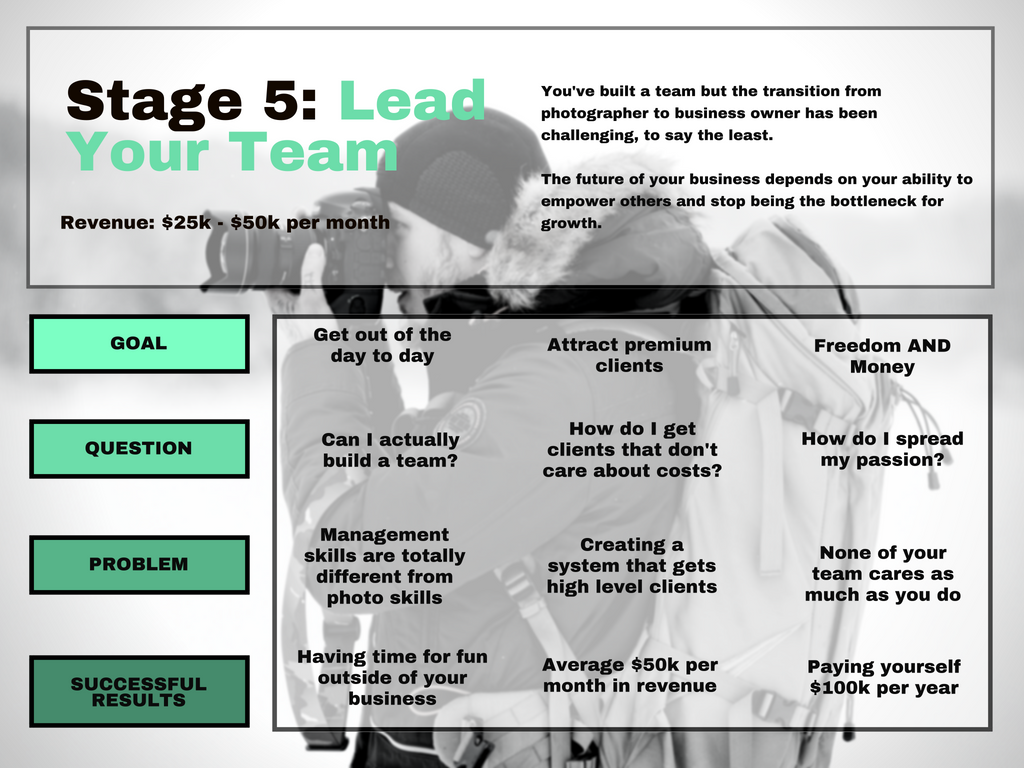
You’ve built a team but the transition from photographer to business owner has been challenging, to say the least. The future of your business depends on your ability to empower others and stop being the bottleneck for growth.
Revenue: $25,000 – $50,000 per month
Problem: You’ve got team members and they’re doing a decent enough job, but you know that to get to the next level, you’re going to have to make some hard decisions. You’re starting to question if leading others is something you even want or if you just want to go back to a simpler life of a solo photographer.
In your current state, you’re not only trying to get new photography clients regularly, but you’re trying to get your ideal client: the perfect client that is a dream to work with and refers other dream clients to you.
AND, despite your business making 300,000+ per year, it’d be nice if you could start getting at least $100k of that.
How to Be Successful: First, if you’re here, can I just give you a pat on the back and a congratulations? This is amazing. You’ve done SO MUCH right so far just to get here. You’re in the top 5-10% of all photographers in the world and you should be proud of yourself.
But I’m guessing that you aren’t, because the kind of photographer that gets to this level isn’t the kind that is willing to settle down. You’re still working 12 hour days (at least) and you now know for sure that you’re holding your team back.
Let’s put it this way: If you go on vacation for two weeks, the business falls apart.
It’s time to transition fully from photographer to leader.
Ready to hire somebody to really take your marketing to the next level? Let’s chat.
It’s time to set standard operating procedures (SOPs) so that everybody on your team knows what they’re supposed to be doing.
Quick tip: Every time you execute a task, document it with a video on your computer. You can sketch out notes later but this will help bring your team on board with how things should be done.
Here are a few things that you’re going to run into:
- Planning on months and years in advance
- Filling a pipeline not only with clients, but also with photographers that want to work with you
- Figuring out your team “culture” and what is going to keep people in love with working for you
- Making data-based decisions in your business like client acquisition costs, client lifetime value, cancellation rates, etc.
- Inspiring your team to join you in your overall mission
Whether you’re there or not, the business has to keep running.
You know you’re firmly at this stage when your team (not you) is helping to generate $300,000+ per year in revenue and you can step out of the daily operations of your business. You’re not answering emails from leads. You’re not telling people where to be and when. And finally (FINALLY), you’re making six figures per year and enjoying the life you’ve built for yourself.
If you’re like me, that means spending more time with your spouse and kids. Or maybe starting something new?
Like I said above, starting a photography business and scaling it to this level takes a certain kind of entrepreneur and if you’re that kind of person, you aren’t going to suddenly be satiated by this short period of time.
If you’re like me, you feel a sort of stewardship around living up to your potential and achieving as much as possible to honor those who came before you and worked so hard to get you the opportunities that you’ve been afforded.
It’s this very unique type of photographer / entrepreneur that reaches this point and is ready for Stage Six….
Stage 6: Scale Your Photography Business and Become and Entrepreneur
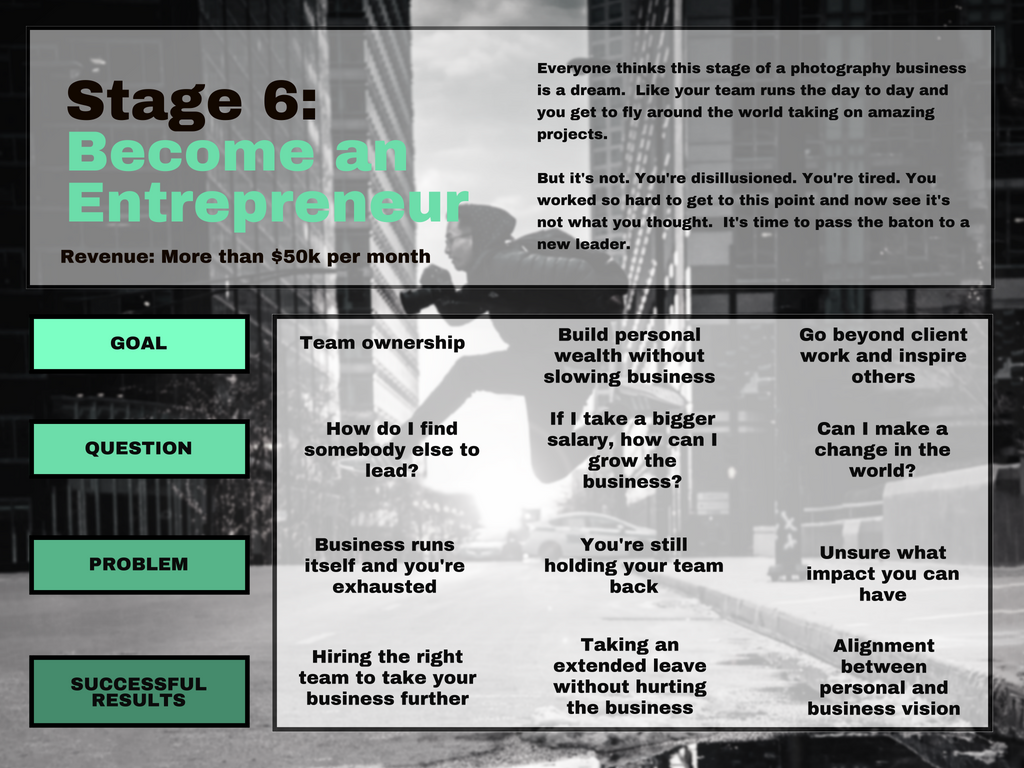
Revenue: $50,000+ per month
Problem: Where does one even go from here? You’ve scaled up your business, have a rock-solid team, and things are moving along. But now what? Do you have purpose or impact? Has your business become so overly-complex that it’s impossible to manage?
You know the next level looks like a bigger impact and is going to require a vision that empowers your team to become photographers like who you were just a few short years ago. But how do you keep them working with you and not starting their own business?
How to Be Successful: It’s time to start syncing up with other high-level photographers and entrepreneurs.
Remember how this stage used to look for you: all fun and games while the business runs itself?
Not the case, eh? You’ve learned that you never “arrive.” There is no “there” off in the horizon as a destination.
The best thing about what you’ve built is that now you have a platform to speak from and a chance to help others. When you started your photography business, you thought things were going to be pretty simple.
And while we have a free course for those just starting their photography business (Stage 1) and paid courses for those in Stages 2 and 3, what you need now isn’t more education; you need connection.
It’s time to start getting into genuine mastermind groups with other entrepreneurs at your level.
What stage of growing your photography business are you at now?
Of the six stages of starting your photography business, which are you currently in?
Learn more about our free email course and our paid courses and how you can level up your photography business.
I’m looking forward to hearing more about your story, your business, and your photo biz goals in the comments below. Also, what is ONE THING nobody told you that you wish you knew when you decided to start a photography business? Post a comment below!
